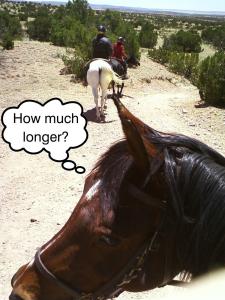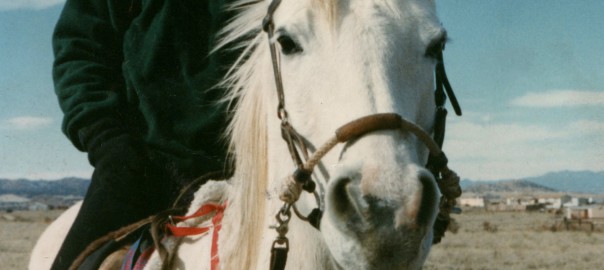
When should I stop riding my older horse? This question comes up periodically, because at some point in every horse’s life, they get too old to be ridden. That’s the truth of the matter. They simply don’t enjoy it any more, and even if they do, they are physically unable to continue to carry a rider safely.
- Riding my mare Opal one blustery day when she had a lot of energy. She was retired early because of melanomas. Photo taken Winter, 1998.
Some older horses have “good days and bad days,” so you will find that some days you have more horse than on others. Maybe the weather makes her feel young again, and she has more energy.
 A man rode his two older horses until each of them in turn stumbled and went down with him on the trail. This was highly unsafe for him, and his vet told him he should stop riding each of them after that. I also wonder what indications the horses gave him before they went down with him – were they wobbly? Stumbly? There are usually some signs that the horse is unstable before they actually fall.
A man rode his two older horses until each of them in turn stumbled and went down with him on the trail. This was highly unsafe for him, and his vet told him he should stop riding each of them after that. I also wonder what indications the horses gave him before they went down with him – were they wobbly? Stumbly? There are usually some signs that the horse is unstable before they actually fall.
An older competitor had surges of energy, however, he fell with his owner and was very sore afterwards. Fortunately she was not hurt. When the vet examined him, he told her to stop riding him. She was stricken because he loved to jump. I said you don’t want to be on him when his body fails him. When horses fall, that’s 1,000 pounds or more going down to the ground. Think of what that does to aging, weakening bone structure. If something doesn’t break, then tendons and ligaments get stretched and the whole structure gets way out of alignment.
That’s how it is with old performance horses. They love to keep going, if they loved their jobs. Also, if you’ve had a horse for a long time, he doesn’t want to disappoint you. He wants to keep trying for you, usually well past his ability to do certain things. In cases like this, we have to take the initiative, really look into his desire and weigh it against his physical ability. The ability to carry a rider is something that a horse has to develop when it’s young. During the aging process, the ability to carry a rider begins to diminish, so that eventually they can carry a small rider or child on even footing, but not on rough trail, and not for very long. Their backs, legs and joints may hurt. They may have some neurological disconnect going on. After awhile, you can generally sense when it’s no longer safe to let anyone on the horse’s back; when he stumbles too much, has too little energy, lies down a lot or doesn’t want to move with a rider. Then it’s really time for full retirement.
“Out to pasture” is an expression that suggests that the horse is always going to enjoy being out on pasture, when in fact, for some horses, pasture in old age is too hard on them. They may need the movement pasture provides but also need more daily attention, comfortable shelter and bedding for their various conditions. The horse who has taken care of you for many years, now needs you to take care of him or her, kind of like aging parents!
Geriatric horses who can’t be ridden enjoy lots of other activites such as walks (and walking meditations), maybe playing ball or games involving food, and liberty training. Sometimes horses have to retire from riding because of other physical conditions. I put geriatric and compromised horses on a regular maintenance bodywork program, that can be monthly, every six weeks or two months – generally dictated by their condition and what the owner can afford. I also teach the owner a number of techniques to help their horse be more comfortable and so they don’t require as many bodywork sessions. In many cases I use herbs in place of commercial supplements as I have found they work better and cost a fraction of the store-bought preparations. None of these recommendations take the place of veterinary care, however, and I am happy to work with vets on holistic treatment plans for older horses, complementing the course of action the vet has chosen for the horse.
Walking meditations can help ground you and the horse. Watch how his feet touch the ground when you begin. Is the hoof touching the ground from heel to toe or toe first? Is he walking on the inside or outside of his feet? Think about sending your energy down through your legs and feet into the ground, then start walking with your horse. Listen for his footfalls. Turn and see how he’s doing. He should begin to place his feet more solidly on the ground and make a better connection with it after ten minutes, maybe sooner.
******
Fascinating article on Ortho-Bionomy: Better than a pain pill? PostIndependent.com
A good way to experience work on yourself besides having a people session is to have a horse and rider session. For those who want to experience horse and rider work, take advantage of $10 off one session with me – good for the rest of August through the end of September.
Services: Bodywork (Ortho-Bionomy for people, Equine Positional Release/Equine Ortho-Bionomy): private sessions, tutorials, phone consultations, distance healing and gift certificates
Liberty Training: clinics, mini-clinics, workshops, private and semi-private sessions, tutorials, consultations: by appointment: 505.501.2478 or emailing susansmith@orthohorse.info
Looking forward to Fall Lessons – semi-private, private and small group sessions. Scheduling now. Contact me for details.
The weekend is upon us! I leave tomorrow morning for Oklahoma for the Liberty Foundations Waterhole Rituals Equine Clinic at Spirit Horse Ranch near Oklahoma City, co-teaching: Ruella Yates, Certified Carolyn Resnick Trainer and Susan Smith, Suggested CR Trainer. Liberty Horse Training. September 28-29, 2013. Contact Ruella Yates at ruella@libertyfoundations.com, or 405-771-4274. Susan will be giving a three-hour tutorial on her OrthoHorse bodywork for a limited number of students. Call 505-501-2478 or email susansmith@orthohorse.info for details. Look forward to seeing many of you there!





Great article, Susan. My boys are getting older and I watch them very carefully. We hike/walk together more than I ride them. They love it and we are still being active TOGETHER.
Thanks, Leslie. That’s wonderful that you hike with your boys, I’ll bet they really enjoy that, and getting to spend time with you.